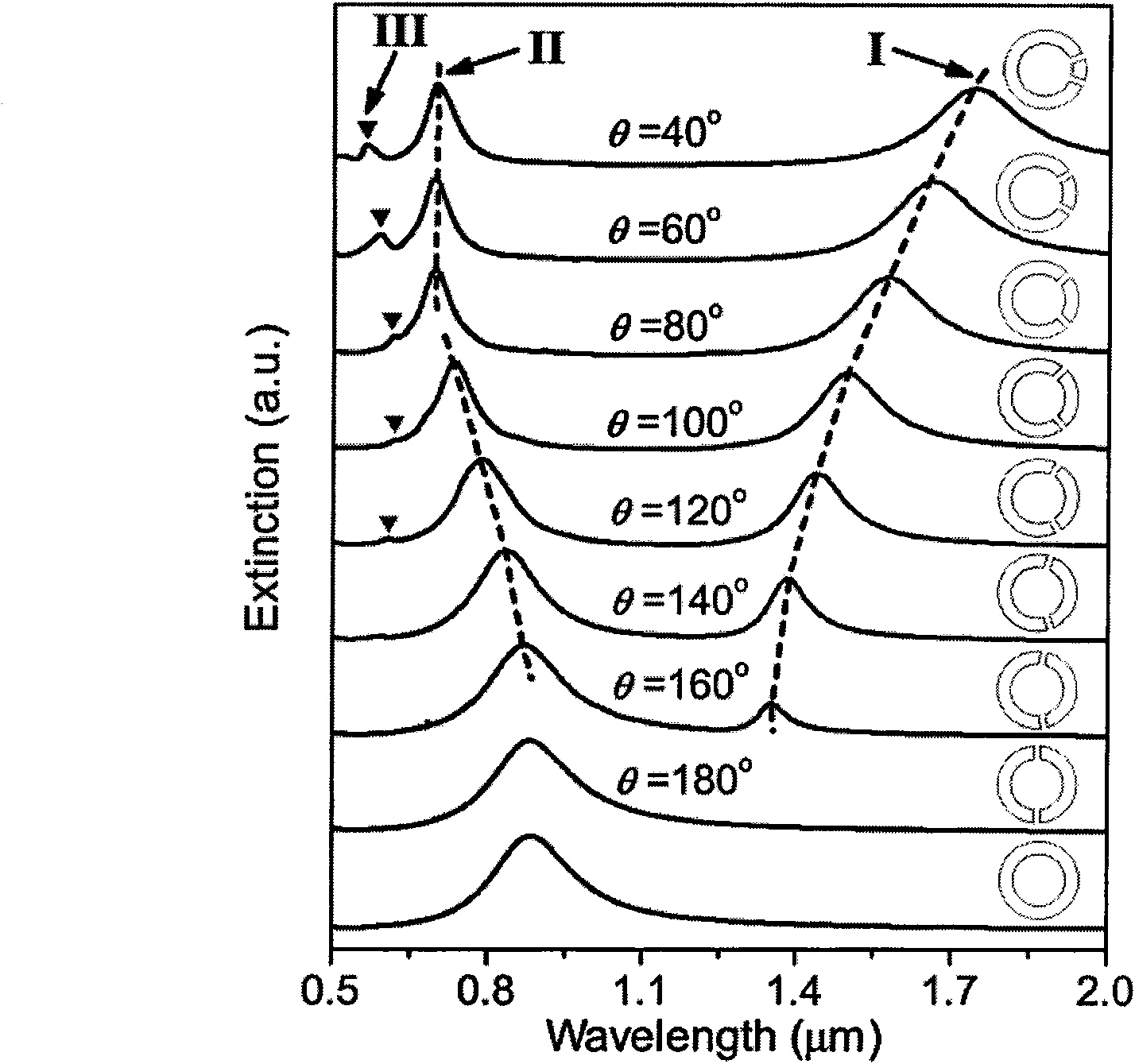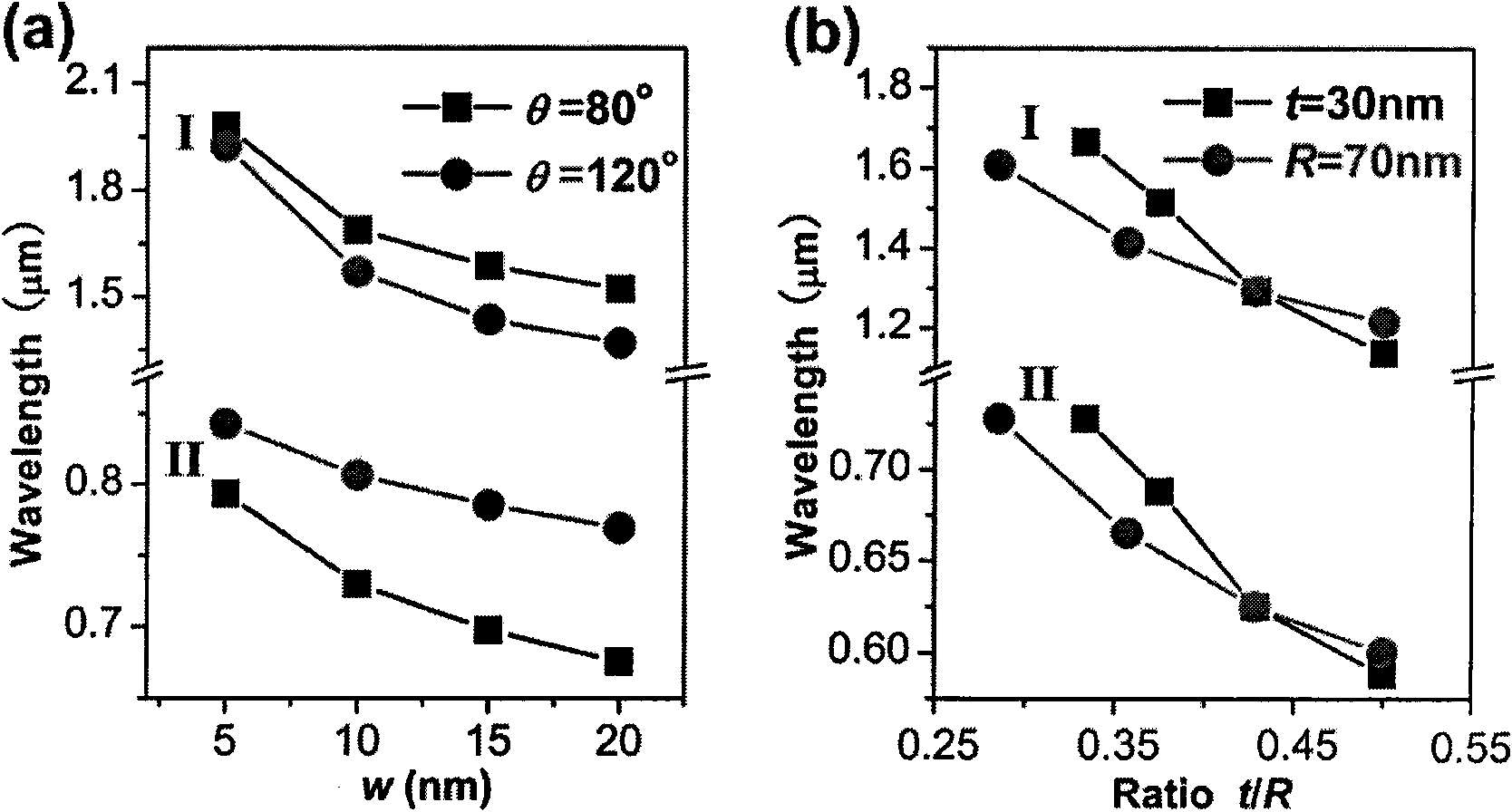Surface-enhanced optical spectrum underlay of unsymmetrical double-split ring
A surface-enhanced spectroscopy, asymmetric technology, applied in the field of surface spectroscopy, can solve the problems of poor reproducibility of surface-enhanced spectroscopy, poor controllability of nanoparticles, etc., and achieves narrow crack width, high stability and reproducibility, and high electromagnetic field enhancement. effect of effect
- Summary
- Abstract
- Description
- Claims
- Application Information
AI Technical Summary
Problems solved by technology
Method used
Image
Examples
Embodiment 1
[0028] Such as figure 1 As shown, referring to the document [K.Li et al., Surface enhanced Raman scattering onlong-range ordered noble-metal nanocrescent arrays, Nanotechnology 19 (2008) 145305 / 7] disclosed nanoimprint lithography (nanoimprint lithography), the A metal (gold) ring is split into two sections of metal arcs with different arc lengths, as an asymmetrical double-split ring structural unit 2, and then the structural unit 2 is placed on the plane of the substrate glass 1 along two-dimensional two-axis (X-axis, Y-axis) are all arranged in a period of P=320nm to form a two-dimensional array, wherein the structural parameters of the asymmetric double-split ring structure unit 2 are: ring outer diameter R=90nm, ring width and thickness t=30nm, A metal arc with a shorter arc length corresponds to a central angle of θ=100°, a metal arc with a longer arc length corresponds to a central angle of 260° (360°-θ), and the gap width between the two arcs is equal, and the gap widt...
Embodiment 2
[0033] The extinction performance and electric field enhancement effect of gold asymmetric double-split ring surface-enhanced spectroscopy substrates:
[0034] For the structure and parameter definitions of asymmetric double-split ring arrays, see figure 1 , fixed period P, ring outer diameter R, ring width and thickness t, and slit width w (P=320nm, R=90nm, t=30nm, w=15nm), change the positions of the two slits at the same time or set the parameter θ at an interval of 20° Varying from 180° to 40° can result in double-split ring array structures with different asymmetries. The extinction spectra of gold double-cleaved ring array structures with different asymmetry such as figure 2 As shown: the asymmetric double-split ring array structure has two strong extinction peaks in the infrared and visible light bands, corresponding to the first-order (I) and second-order (II) plasmon resonances, and the structure of the symmetrical ring (w=0 ) and the symmetrical double-split ring ...
Embodiment 3
[0040] Extinction properties and electric field enhancement effects of silver asymmetric double-split ring surface-enhanced spectroscopy substrates:
[0041] Four different structural parameters [(1) period P=320nm, ring width and thickness t=30nm, ring outer diameter R=90nm, slit width w=15nm, angle θ=120°; (2) P=320nm, t= 30nm, R=90nm, w=15nm, θ=80°; (3) P=320nm, t=30nm, R=90nm, w=10nm, θ=80°; (4) P=320nm, t=30nm, R = 70nm, w = 15nm, θ = 80°] The extinction spectrum of the silver asymmetric double-split ring surface enhancement spectrum substrate is as follows Figure 6As shown: the silver asymmetric double-split ring periodic structure has dual-wavelength resonance performance similar to the gold asymmetric double-split ring periodic structure, and the resonance wavelength can be adjusted by structural parameters, such as when θ = 120° to θ = 80° When the radius R changes from 90nm to 70nm, the resonance peak (I) can be adjusted from 1.369μm to 1.498μm, and the resonance p...
PUM
| Property | Measurement | Unit |
|---|---|---|
| Ring outer diameter | aaaaa | aaaaa |
| Thickness | aaaaa | aaaaa |
| Thickness | aaaaa | aaaaa |
Abstract
Description
Claims
Application Information
 Login to View More
Login to View More - R&D
- Intellectual Property
- Life Sciences
- Materials
- Tech Scout
- Unparalleled Data Quality
- Higher Quality Content
- 60% Fewer Hallucinations
Browse by: Latest US Patents, China's latest patents, Technical Efficacy Thesaurus, Application Domain, Technology Topic, Popular Technical Reports.
© 2025 PatSnap. All rights reserved.Legal|Privacy policy|Modern Slavery Act Transparency Statement|Sitemap|About US| Contact US: help@patsnap.com



